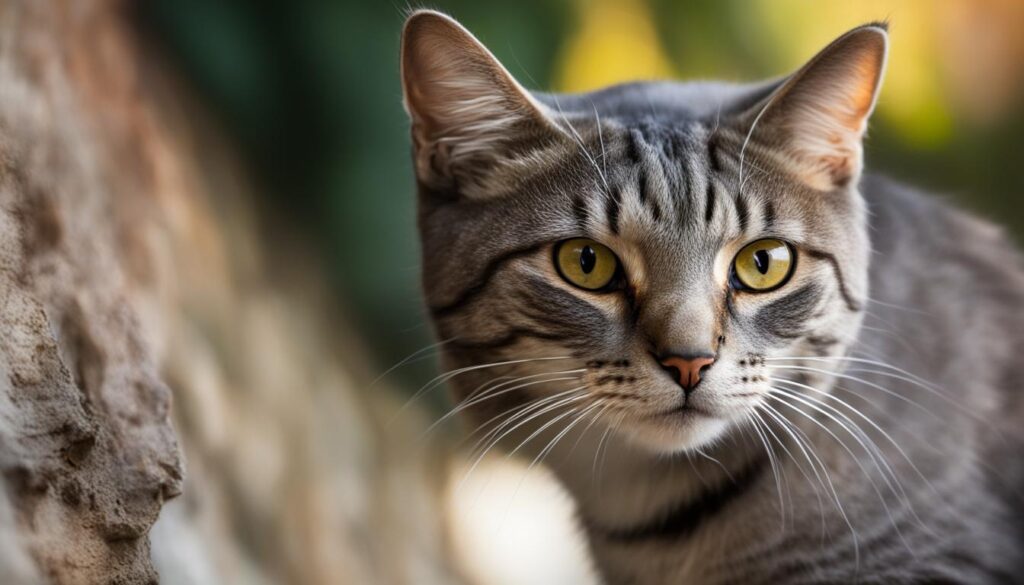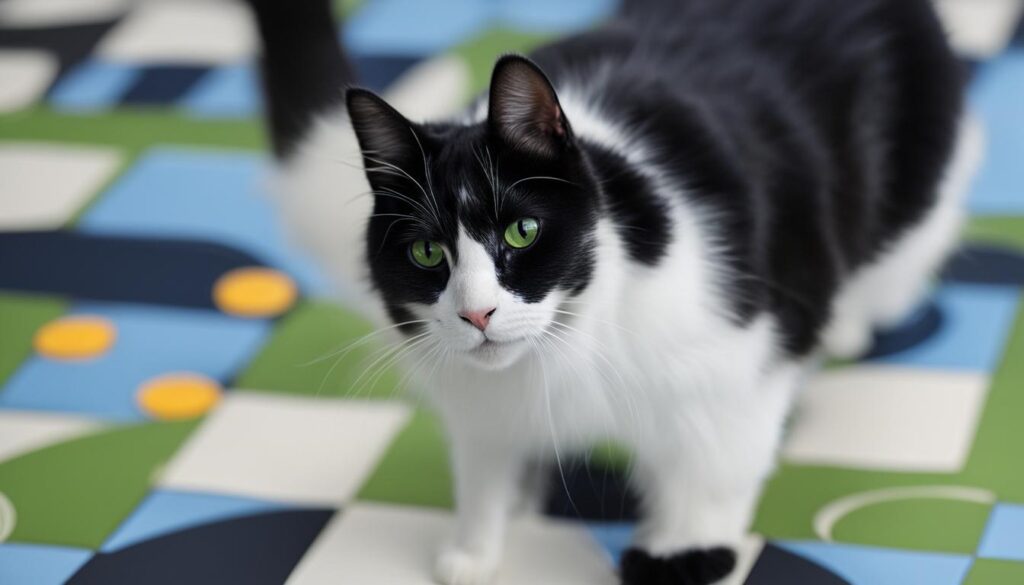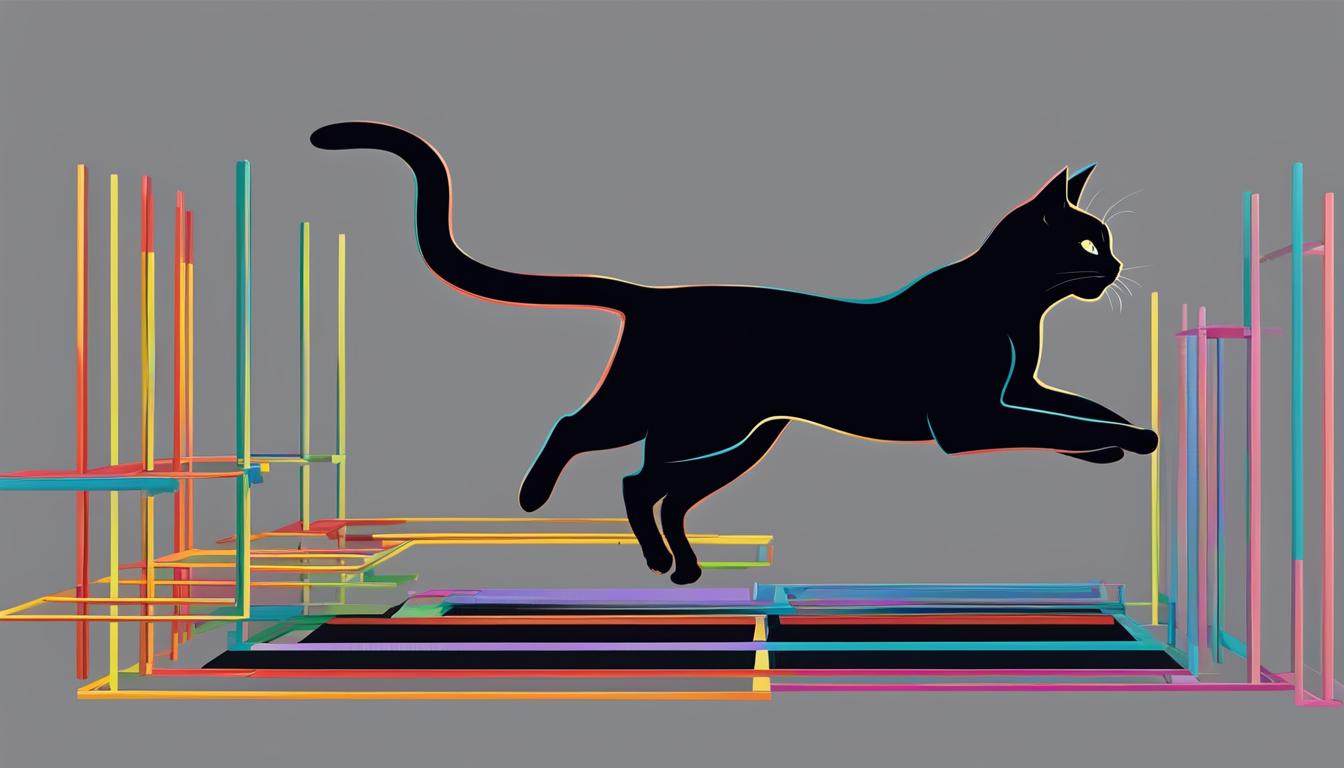Have you ever marveled at the feline finesse of movement? Cats seem to glide effortlessly through life, effortlessly leaping and landing with perfect poise. But have you ever wondered how they achieve such remarkable balance? Join me as we dive into the fascinating world of cat balance science.
Researchers Roman Stocker and Pedro Reis, in their groundbreaking study published in Science, unveiled the secret behind a cat’s perfect balance when lapping liquids. It turns out that cats employ a clever technique – extending their tongues straight down towards the surface, curling the tip backward to touch the liquid. As they swiftly draw their tongues back, a column of liquid forms, which they pinch off with their mouths, keeping their chin dry. This delicate maneuver showcases the intricate harmony between gravity and surface tension that cats, both big and small, have mastered.
Key Takeaways:
- Cats maintain a perfect balance while lapping liquids through a precise tongue technique.
- The balance between gravity and surface tension allows cats to keep their chin dry.
- This balance technique is consistent across domestic cats and their larger feline counterparts.
- Understanding feline proprioception can shed light on their exceptional agility and coordination.
- The study by Stocker and Reis provides important insights into the science behind a cat’s balance.
How Cats Use Whiskers and Ears for Balance
Cats are known for their incredible balance and agility, gracefully navigating even the narrowest of spaces. But have you ever wondered how cats maintain their equilibrium? It turns out that whiskers and ears play a crucial role in a cat’s ability to stay balanced.
Whiskers: Cat whiskers, or vibrissae, are not just for show. These specialized hairs are incredibly sensitive and act as feelers, helping cats gauge distances and navigate their surroundings. Whiskers on their paws, eyes, chins, and legs also contribute to their sensory perception. While not directly related to balance, whiskers provide valuable information about the environment, allowing cats to make quick adjustments and maintain their equilibrium.
Ears: Cats have an intricate inner ear structure that helps them maintain balance. Their ears are equipped with 32 muscles, allowing them to move independently to detect the direction and amplify sounds. This remarkable ability enables cats to pinpoint the location and movement of prey as well as potential threats. The feline inner ear also houses the vestibular system, which is responsible for a cat’s sense of balance. Changes in the inner ear structure can lead to balance issues, especially in older cats.
Understanding how cats use their whiskers and ears for balance is not only fascinating but also essential for providing proper care and addressing any balance issues that may arise. By recognizing the importance of these sensory organs, we can promote the overall well-being and mobility of our feline companions.
| Whiskers | Ears |
|---|---|
| Act as feelers | Equipped with 32 muscles |
| Aid in navigating surroundings | Move independently |
| Provide sensory perception | Amplify sounds |
| Help maintain equilibrium | House the vestibular system |

Common Ear Ailments and Their Effects on Balance
When it comes to a cat’s balance, the inner ear plays a crucial role. However, various ear ailments can disrupt a cat’s equilibrium, leading to balance issues and other neurological symptoms. One such condition is vestibular disease in cats, which affects the vestibular system responsible for maintaining balance. Symptoms include head tilting, stumbling, loss of coordination, and rapid eye movements. Cats with vestibular disease may also show signs of nausea and disorientation. Prompt veterinary care is essential to diagnose and treat this condition effectively.
Aside from vestibular disease, other ear ailments such as mite infestations, bacterial or yeast infections, polyps, and cysts can also impact a cat’s balance. These conditions can cause pain, discomfort, and inflammation, leading to difficulties in maintaining equilibrium. Additionally, certain neurological disorders can affect a cat’s balance and coordination. These conditions may be caused by genetic factors, trauma, or other underlying health issues. It’s important to address these ailments promptly and seek appropriate treatment to restore a cat’s balance and overall well-being.
Neurological Disorders Affecting Cat Balance
Neurological disorders can have a significant impact on a cat’s balance and agility. One such disorder is cerebellar hypoplasia, a condition where the cerebellum, responsible for motor coordination, fails to develop correctly. Cats with cerebellar hypoplasia exhibit unsteady movements, tremors, and difficulties in maintaining balance. Another neurological disorder that affects cats is vestibular syndrome, which is characterized by sudden-onset balance problems, head tilting, and abnormal eye movements. These disorders not only impair a cat’s physical capabilities but also require specialized care and management.
| Ear Ailment | Effects on Balance |
|---|---|
| Vestibular Disease | Disrupted equilibrium, head tilting, stumbling |
| Mite Infestations | Pain, discomfort, inflammation, balance difficulties |
| Bacterial or Yeast Infections | Balance problems, inflammation, discomfort |
| Polyps and Cysts | Pain, inflammation, difficulty maintaining balance |
Preventing injuries and promoting cat agility is essential, especially for cats with balance issues or neurological disorders. Creating a safe environment with padded surfaces and removing potential hazards can minimize the risk of falls and injuries. Regular veterinary check-ups, including ear examinations, can help detect and address any ear ailments or neurological issues early on. Environmental enrichment, such as providing interactive toys and engaging in playtime, can also help to improve a cat’s balance, coordination, and overall well-being.

The Importance of Ear Health for Cats
When it comes to a cat’s balance, good ear health plays a crucial role. Regular veterinary check-ups should include an examination of the ears to ensure they are free from infections, mites, and other ailments that can affect a cat’s balance. But ear health goes beyond just prevention and treatment. It is also essential to implement training exercises to improve a cat’s balance, especially in cases of balance impairment or rehabilitation.
Training exercises for cat balance can help strengthen their muscles and enhance their proprioception. Proprioception is the ability to sense the position and movement of the body, allowing cats to have a better sense of control over their movements. Simple exercises like walking on narrow surfaces or using puzzle toys that require balance can help improve a cat’s overall stability and confidence.
“Balance-impaired cats can greatly benefit from exercises that challenge their balance and coordination. It is important to start with exercises that are appropriate for their current ability level and gradually increase the difficulty as they progress.” – Dr. Sarah Johnson, Feline Rehabilitation Specialist
Environmental enrichment also plays a significant role in providing cats with opportunities for balance training. By creating a stimulating environment with vertical spaces, cat trees, and interactive toys, cats can naturally engage in activities that require balance and agility. This not only promotes their physical well-being but also provides mental stimulation.
| Exercise | Benefits |
|---|---|
| Walking on a wobble board | Improves core strength and balance |
| Hunting for treats in a treat-dispensing toy | Enhances mental stimulation and balance control |
| Jumping through hoops | Increases agility and coordination |
By prioritizing a cat’s ear health, incorporating training exercises, and providing environmental enrichment, cat owners can help their feline companions maintain optimal balance and agility throughout their lives. So remember, the next time you are engaging with your cat, take a moment to appreciate the incredible importance of their ears in their overall well-being.

Conclusion
As I’ve delved into the fascinating world of cat balance science, it’s become clear that our feline friends possess an extraordinary ability to maintain equilibrium. From the elegant movement of their tongues to the intricate workings of their whiskers and ears, cats have developed a finely tuned system that allows them to navigate their surroundings with unparalleled finesse.
However, it’s important to recognize that balance issues can arise, posing challenges to our cats’ well-being. Vestibular disease in cats and neurological disorders can disrupt their sense of balance and mobility, leading to discomfort and difficulty in their day-to-day lives.
Fortunately, there’s hope for balance-impaired cats. With proper rehabilitation and care, we can help them regain their stability and lead fulfilling lives. By implementing training exercises and providing environmental enrichment, we can support their journey towards better balance. It’s crucial to remember that these cats need our understanding and support as they navigate the world in their unique way.
By promoting awareness of cat balance science and the impact of vestibular disease and neurological disorders, we can contribute to the well-being of cats everywhere. Let’s continue to explore the wonders of feline proprioception and provide the necessary care and attention to help balance-impaired cats thrive.
FAQ
How do cats maintain balance while lapping liquids?
Cats extend their tongues straight down towards the bowl, forming a column of liquid that they pinch off before closing their mouths, keeping their chins dry.
Do whiskers play a role in a cat’s balance?
Whiskers serve as feelers that help cats gauge distances, size up objects, and navigate tight spaces. They are not directly related to a cat’s balance, which is controlled by the inner ear.
What is the role of a cat’s ears in balance?
Cats’ ears are equipped with 32 muscles that enable them to move independently, allowing them to detect the direction and amplify sounds. This helps them determine the location and movement of prey and potential threats. Balance issues in older cats may be caused by changes in the feline inner ear structure.
What can cause balance issues in cats?
Balance issues can be caused by ear ailments such as mite infestations, bacterial or yeast infections, polyps, and cysts. Neurological disorders can also impact a cat’s balance and agility.
How can I improve my cat’s balance?
Regular veterinary check-ups should include an examination of the ears. Training exercises and environmental enrichment can help improve a cat’s balance, especially in cases of balance impairment or rehabilitation.
Should I trim my cat’s whiskers?
No, you should never cut or trim a cat’s whiskers as they are a sensory organ and play an important role in their perception of their surroundings and balance.
Why is ear health important for a cat’s balance?
Proper ear health is essential for a cat’s overall well-being and balance. Promptly addressing any ear ailments can help maintain optimal balance and agility.
How can I support a cat with balance issues?
Rehabilitation and environmental enrichment can play a crucial role in supporting a balance-impaired cat, allowing them to lead happy and fulfilling lives.





